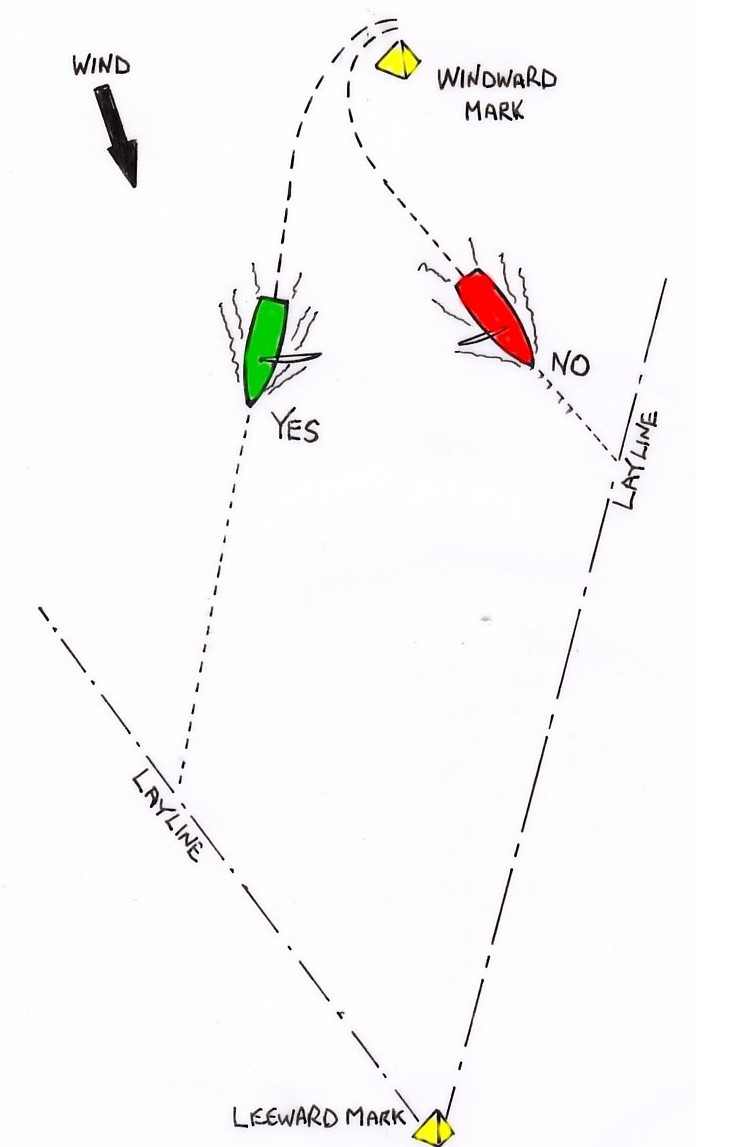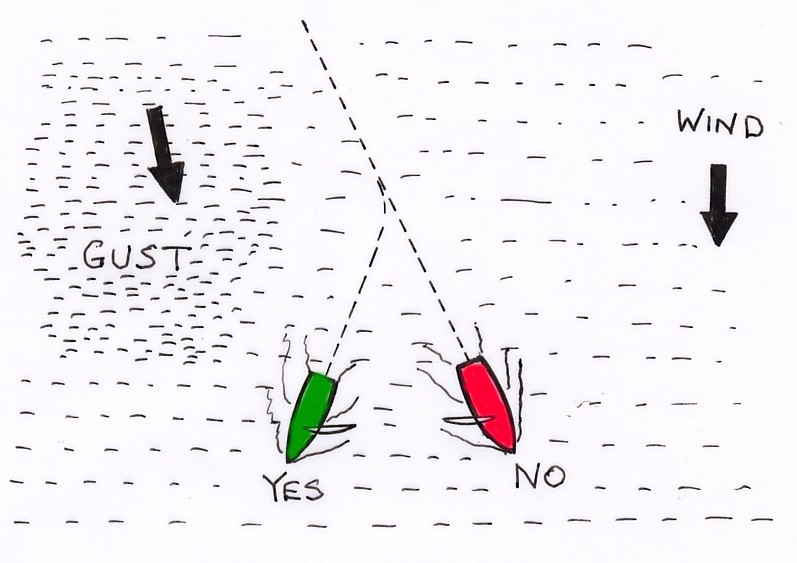Sailing
Faster Reaching and Down wind Strategy
By Alan Gillard
Most people concentrate on upwind speed and trim but ask little about down wind and reaches.
SAIL TRIM
Close reaching.
Use your telltales the same as for upwind. (Leech tell-tales flying all the time). Use your kicker to set the overall fullness of the sail, let the outhaul off a little bit (but not too much), and let the downhaul off until the front of the sail starts to wrinkle (speed ripples). The mainsheet is then used to control the angle of the sail to ensure the tell-tales are all streaming. If you start to become overpowered on a close reach try pulling on more downhaul, this will have the effect of opening up the leech and so depowering. As you come off the wind more, ease the outhaul to power up the sail.
Broad reaching.
On a broad reach it's more difficult because the boom and sail are limited in how far out they can travel by the shrouds. Let the outhaul nearly right off (i.e. make the sail really full low down), and the downhaul fully off. The top tell-tales are the most important on a broad reach and the kicker is the most important control. On a broad reach the bottom of the sail is generally stalled because the boom can't go out far enough. But if you let your kicker off a bit, the sail will twist so you can still get some flow over the sail and keep the top telltales streaming properly. The trick here is to play the kicker while going downwind. Being a high aspect ratio sail, it is very sensitive to wind pressure. Thus, when a gust hits, the sail twists way too much (above the blue band) and you lose power, so you must pull the kicker on to control the twist. This is especially important in strong wind’s, because if you let the sail twist too much it develops power in such a way that it will roll you in to windward! Conversely, when the gust dies, your sail will stall unless you let the kicker off again to let the sail twist and get the top flowing again. All of this need’s to be co-ordinated with heading up a bit in the lulls, and bearing away in the puffs.

Dead down wind – TRIM AND STRATEGY
Streakers are just not great at going dead down wind. The boom will not go square enough to the wind, the shrouds being to far aft restricting the sail and boom. Letting the kicker off as much as you dare helps, but the sail opens up too much loosing power, tweaking the kicker again then reduces your ability to obtain that dead downwind angle. The answer is to broad reach more and put in the occasional gybe. Streaker sailing down wind is a bit like sailing an Asymmetric spinnaker boat (RS200, 400 etc.).
There are some good rules of thumb, which apply as much to an Asymmetric spinnaker boat as it does for us, we can use these to go faster as well.
1. Sail the longer gybe first.

As with beating up wind there are lay-lines, which become in racing terms a strategic dead end. As the longer tack to the next windward mark is the first tack you should take. It’s the same for downwind sailing, take the longer gybe first, it’s the one that you will spend more time on during the run. It means that you will stay closer to the middle of the course. But also remember the wind shifts downwind as well as up and by staying to the middle of the course you will be in a better position to take advantage of any future wind shift.
2. Pressure before shifts.

It’s always better to have more pressure when you are racing downwind. The boat goes faster and you are able to run deeper and so sail closer to the angle for the leeward mark. So go for pressure first downwind, especially in light winds.
3. Sail away from the next shift.

Upwind you always gain from sailing towards the next shift (header). It’s a bit like snakes and ladders, you just climb up to the next rung on the ladder i.e. header. On a run, the opposite is true; you should always sail away from the next shift so you get a lower ladder rung. The overriding factor being a gust, more pressure. A boat planning is so much faster.
4. Gybe on the lifts.
We all know that tacking on the headers upwind is right. Downwind it is the opposite we need to gybe on the lifts. It might feel strange and it is certainly harder to spot on the water, but if the wind was coming over your aft corner and suddenly it’s coming over your transom its time to gybe. By staying on the headed gybe you can sail lower and closer to the leeward mark. The Asymmetric boats see the shift because the spinnaker collapses as the mainsail then blankets the spinnaker, so the RS200 would then gybe to get his 3 sails filling again.
Click here for downloadable PDF version of this article - Faster Reaching and Down wind Strategy
Windy Streaker Sailing
By Alan Gillard
As any of you who have tried it will know, windy weather Streaker sailing can be a difficult, but exciting experience that needs some practice and preparation to enable you to enjoy it to the full. To start with the boat isn't very well balanced on the helm. Upwind, despite it's obvious natural love of heading into wind, the boat becomes difficult to tack and maintaining the optimum heading needs excessive rudder movement if you are to keep on top of things.
Downwind, just as you're thinking "whoopie here's that really fast reach I've been waiting for", you set off to find that the boat keeps trying to broach out of control, with the rudder cavitating wildly just when you need it most. After many hair raising moments myself, besides plenty of practice, I've found the best way to overcome these problems is actually rake the rudder forward by up to 10 degrees. I also believe that the rudder should be towards the minimum width, i.e. 200mm wide. Raking the daggerboard aft in the boardcase also helps, but the rest is a matter of technique and speed of reaction to the wind and waves as the try and knock you off course.
Given you've survived the reach, there is every possibility this will be followed, or punctuated by a Gybe!!!! Which as everyone knows can be one of the hairiest manouvers in a stiff breeze no matter what class of boat you sail. Before I pass comment on this particular problem, let me say I don't profess to be an expert on windy weather gybes, but I do believe that good preparation before you go for the gybe can help improve your chances of avoiding testing the coldness of the water. What do I mean by preparation, well like every other part of you race, some degree of forward planning is essential, so lets start a few lengths away from the point we want to gybe and take each element as it arises:
1. The daggerboard should be pushed fully down, but angled aft, for stability - this also gives you something to stand on if you get it wrong, but lets not be defeatist just yet.
2. The kicker should be freed off a touch to let the boom rise up - this lets the leach of the sail twist off to leeward and helps dissipate unwanted power as you complete the gybe. Plus the out board end of the boom rises a few inches and lessens the risk of it hitting the water, which in turn could seriously add to any momentary loss of control.
3. As you approach the gybe, make sure you keep the power on and the boat planing as fast as you can and try to pick you spot - look behind for any big gusts that will hit you when you're at your most vulnerable and look around you for some flat water, especially important if you sailing in a confused sea.
4. Bear away positively, but whatever you do don't throw the boat at the gybe, instead you should turn progressively away from the breeze. 5. Just as the wind is moving directly behind the boat, try and sheet in some mainsheet and then as you see the top third of the leach begin to twitch, pull the sail over as early as you can - the later you leave it the harder it swings across and more chance there is you'll go for that swim you've been trying so hard to avoid. You should find that not only does sheeting in the main a touch mean you can control the sail as it slams over onto the new gybe, but it also means the wind can get around the back edge of the leach a fraction earlier and this will actually help you get the boom over earlier that would otherwise be the case.
6. The very second the sail starts to come over, centre the helm, in fact you can almost reverse the helm as if you are canceling the gybe. The reason for this is to keep the boat stern into the wind until you've got complete control of the situation, then you can head up and wind the power back on again and worry about picking your way though the boats that didn't make it. Of course as the boom comes across you must also move your weight smartly form one side to the other, to counteract the force of the main sail changing side. One other thing, keep as far aft in the cockpit as you can to stop the bow form digging in. Above all else don't just sit there and wait for the boom to sing across on it's own, because by then it's to late and both the momentum of the sail crashing across and the force of the wind hitting you beam on will spell disaster and it will be time to look for the soap and a towel before you can blink.








